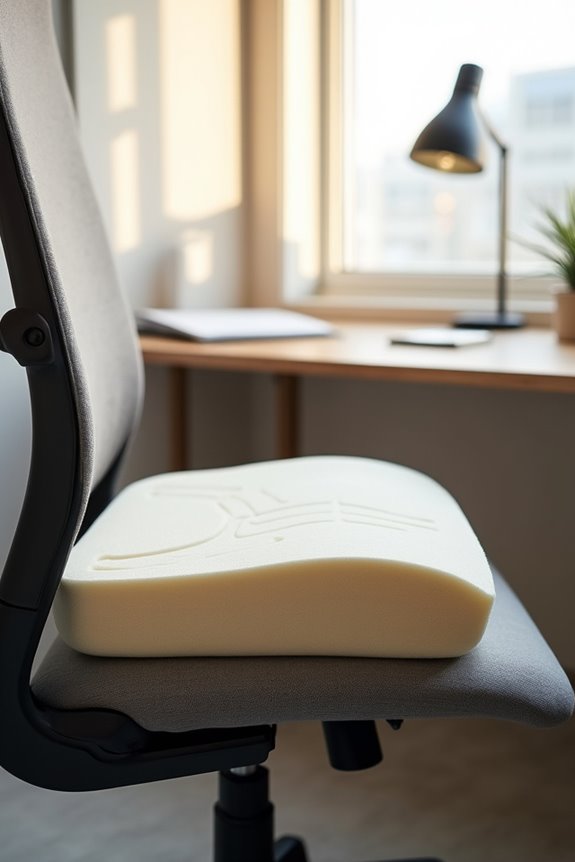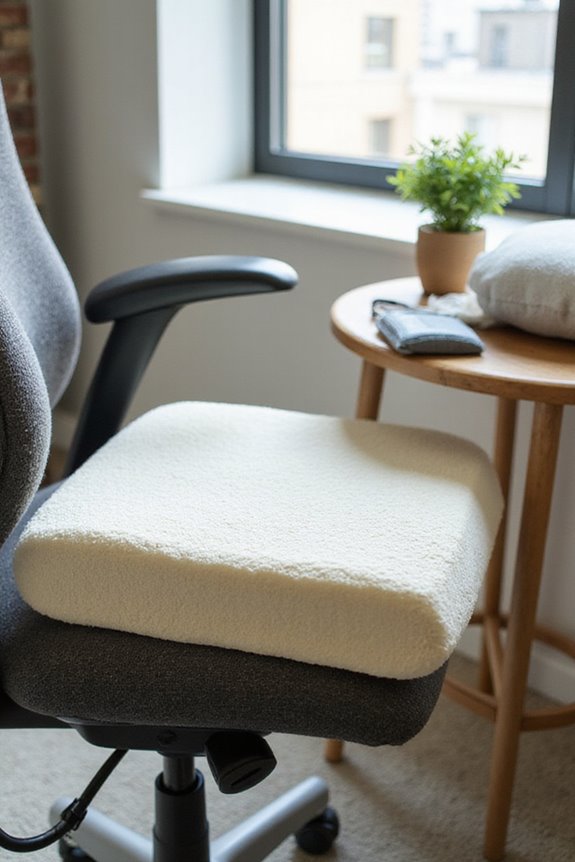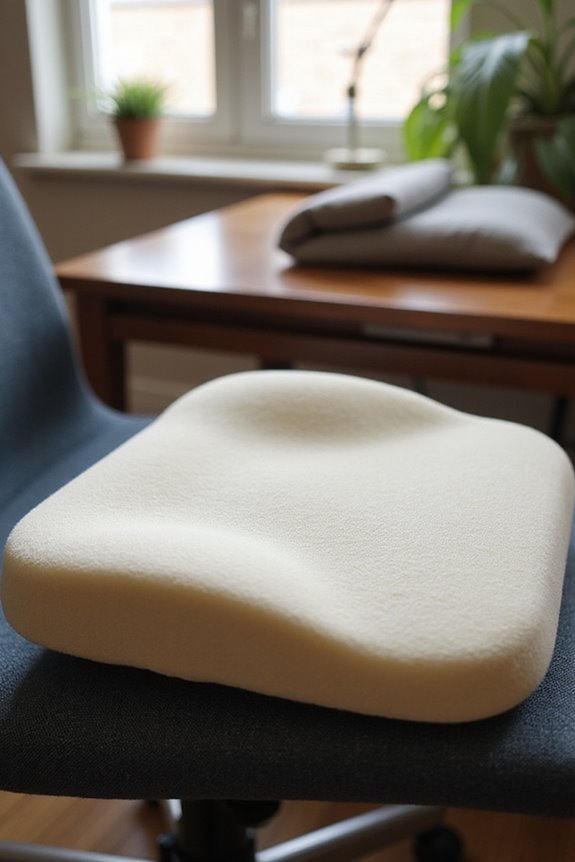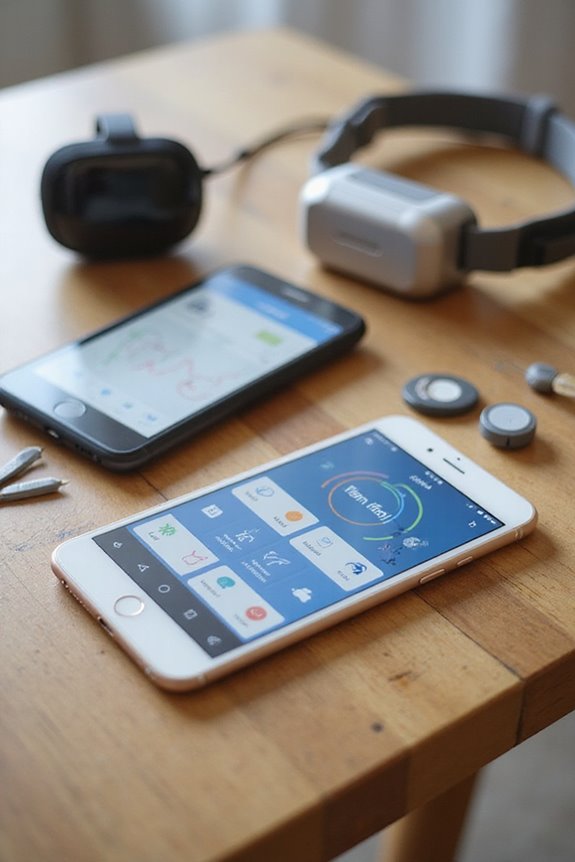Memory foam cushions are effective for chronic pain relief due to their supportive properties. Key benefits include:
- Contouring to body shapes for ideal spinal support.
- Even weight distribution that minimizes pressure on sensitive areas.
- Enhanced circulation and comfort, vital for pain management.
High-density foam offers durability and sustained support, lasting up to 10 years. Their ability to adapt to individual needs makes them suitable for various environments. More detailed insights on usage and effectiveness follow.
Key Takeaways
- Memory foam cushions provide targeted support and pressure relief, essential for managing chronic pain conditions effectively.
- They contour to the body shape, promoting spinal alignment and reducing muscle fatigue during rest.
- By distributing body weight evenly, memory foam minimizes stress on pressure points like shoulders and hips.
- High-density foams maintain their shape and support for up to 10 years, ensuring long-term pain relief.
- Enhanced comfort from memory foam can improve overall quality of life for chronic pain sufferers.
Understanding Chronic Pain and Its Causes
Chronic pain is a complex and multifaceted condition that affects millions of individuals worldwide. It persists beyond three months, often resulting from tissue damage, nerve dysfunction, or psychogenic causes. Pain perception varies greatly among individuals and can manifest as sharp, dull, or burning sensations.
Key characteristics include:
- Continuous or intermittent pain intensity.
- Psychological factors such as anxiety and depression intensifying pain modulation.
- Biological changes, including central sensitization, where the nervous system remains reactive.
Common causes include arthritis, fibromyalgia, and conditions with overlapping factors. Risk factors encompass genetics, prior injuries, and lifestyle choices, affecting diagnosis and treatment. Understanding these elements is essential for effective pain management strategies and enhancing quality of life for those affected.
The Role of Memory Foam Cushions in Pain Management

Memory foam cushions play a significant role in pain management, particularly for individuals experiencing various chronic pain conditions. Utilizing advanced memory foam technology, these cushions provide targeted support and comfort.
Key Features of Memory Foam Cushions:
- Pressure Relief: Contours to the body, alleviating pressure points.
- Posture Support: Encourages proper posture, essential for long-term back health.
- Specific Pain Relief: Effective for conditions like sciatica, herniated discs, and arthritis.
- Durability: High-density foam offers long-lasting support.
These cushions are integral components of pain management strategies, improving overall quality of life. By reducing discomfort and enhancing circulation, they also promote relaxation, making them suitable for various settings, including home and workplace environments.
Benefits of Memory Foam for Spinal Support

Effective spinal support is a critical factor in alleviating discomfort associated with various musculoskeletal conditions. Memory foam’s adaptability allows it to contour to individual body shapes, providing essential spinal curve support. This conforming property helps maintain correct alignment, reducing unnatural bending and twisting of the spine.
- Even weight distribution promotes spinal alignment during rest.
- Enhanced support along spinal curves minimizes muscle fatigue and discomfort.
- Memory foam disperses pressure evenly, reducing stress on spinal discs and nerves.
- It aids in maintaining proper posture, regardless of sleeping position.
How Memory Foam Cushions Alleviate Pressure Points

Pressure points can greatly impact comfort and well-being, particularly for individuals with chronic pain. Memory foam cushions effectively alleviate these pressure points through several mechanisms:
- Weight Distribution: Body weight is evenly distributed, minimizing stress on specific areas.
- Customized Support: Memory foam molds to various body shapes, ensuring targeted relief for pressure points like shoulders and hips.
- Response to Body Heat: The material softens with warmth, enhancing conformity to the body’s contours.
- Material Variety: Different types, such as gel-infused and plant-based foams, cater to individual comfort levels and specific needs.
Enhancing Posture and Alignment With Memory Foam

Proper posture and spinal alignment are essential for overall health, particularly for individuals experiencing chronic pain. Memory foam cushions enhance postural awareness by conforming to the body’s natural curves, promoting neutral spinal alignment.
Key benefits include:
- Support for Spinal Curves: Maintains lumbar and cervical alignment, reducing twisting forces on vertebrae.
- Pressure Distribution: Evenly disperses body weight, alleviating stress on hips and lower back.
- Muscle Relaxation: Supports natural positioning, facilitating recovery and improving circulation.
- Ergonomic Practices: Adapts to various body types, ensuring comfort during prolonged sitting.
Incorporating memory foam into daily routines can markedly enhance posture and minimize chronic pain triggers, making it a practical solution for individuals seeking effective pain management.
Durability and Comfort: Long-Term Benefits of Memory Foam
Durability and comfort are vital factors when considering memory foam cushions, particularly for individuals with chronic pain who rely on long-term support.
- Foam Longevity: Higher density foams last longer—up to 10 years—compared to low-density options, which may only last 5 years.
- Comfort Retention: Quality foams maintain their shape and support over time, essential for consistent pain relief.
- Usage Patterns: Cushions subjected to frequent pressure deteriorate faster, highlighting the importance of rotating them to extend their lifespan.
- Care and Maintenance: Proper maintenance, such as avoiding excessive moisture and cleaning, is vital for preserving foam integrity.
Specific Use Cases for Memory Foam Cushions in Chronic Pain Relief
Memory foam cushions serve as a practical solution for individuals experiencing chronic pain, particularly in the spine, hips, and lower back regions.
Key Use Cases
- Reducing Pressure: Memory foam cushions alleviate lower back, tailbone, and hip pain by contouring to the body, reducing strain on sensitive areas.
- Enhancing Posture: Promoting spinal alignment, these cushions support healthy posture, essential for office workers and drivers, minimizing discomfort during extended sitting.
- Managing Specific Conditions: Effective for chronic pain types like sciatica and arthritis, memory foam’s viscoelastic properties reduce pressure on nerves and joints, providing non-invasive relief.
- Improving Circulation: By evenly distributing weight, these cushions enhance blood flow, reducing muscle fatigue and discomfort during prolonged periods of sitting.
Frequently Asked Questions
How Long Do Memory Foam Cushions Typically Last?
Durability defines memory foam cushions, typically lasting 2 to 7 years. Replacement signs include visible indentations or reduced support. Factors influencing longevity encompass density, usage frequency, and environmental conditions, emphasizing the importance of proper maintenance for peak performance.
Can Memory Foam Cushions Help With Neck Pain Too?
Memory foam cushions provide tailored foam support that conforms to the neck’s natural curves, promoting spinal alignment. This adaptability can effectively alleviate neck pain, enhancing comfort and overall well-being for individuals seeking relief during rest.
Are Memory Foam Cushions Washable or Easy to Clean?
Research indicates that properly maintained memory foam cushions can last up to ten years. Effective cleaning methods, such as vacuuming and spot cleaning, alongside routine maintenance tips, help guarantee longevity and hygiene for a comfortable living space.
Do Memory Foam Cushions Retain Heat During Use?
Memory foam cushions can exhibit heat retention due to their dense structure. However, advancements in cooling technology, such as gel infusions and open-cell designs, greatly reduce this issue, enhancing comfort and promoting a more restful experience for users.
Are There Specific Brands Recommended for Chronic Pain Relief?
Like a comforting embrace, several brands excel in chronic pain relief. User testimonials highlight the effectiveness of TEMPUR and Amerisleep, showcasing positive brand comparisons that foster a sense of community among those seeking relief and comfort.





